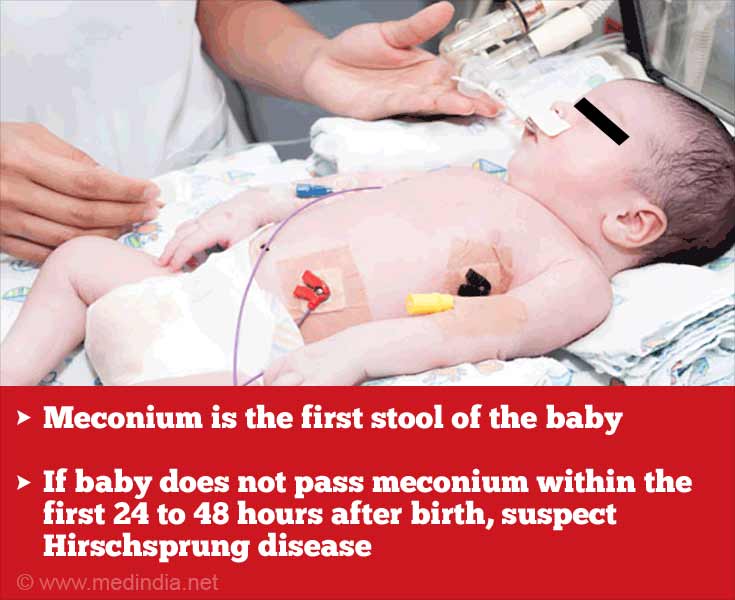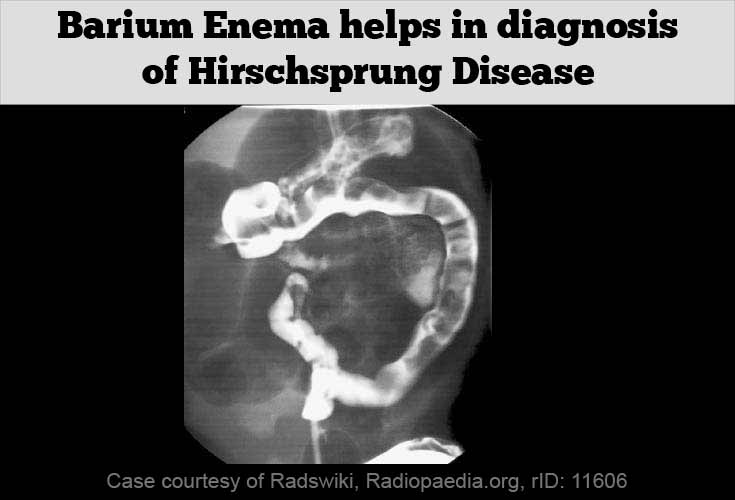- Manipal Manual of Surgery 4th edition
- What is Hirschsprung disease? - (https://www.niddk.nih.gov/health-information/digestive-diseases/hirschsprung-disease)
What is Hirschsprung Disease?
Hirschsprung disease, also known as congenital megacolon, aganglionic megacolon or primary megacolon, is a functional bowel obstruction that usually manifests in newborn babies. It occurs due to the absence of nerves that promote bowel movements in the rectum, anus, and sometimes the colon.
The food in the digestive tract passes from the stomach into the small and then the large intestine, also called the colon. The lower part of the colon continues as the rectum, and then the short anal canal, which opens out as the anus. The anal canal has sphincters to prevent soiling at inappropriate times.
The digestive system is supplied by nerves that control the involuntary bowel movements or peristalsis of the intestines. The parasympathetic nerves embedded in the walls of the intestines promote peristalsis of the intestines and relax the anal sphincter, thereby promoting digestion of food and excretion of wastes. Absence of the parasympathetic nerve cells within the walls of the rectum, anal canal and sometimes the colon from birth results in Hirschsprung disease, named after Hirschsprung who popularized the disease as early as 1886.
What are the Causes of Hirschsprung Disease?
Hirschsprung disease occurs because of lack of parasympathetic nerve cells in the wall of the rectum and anus, and sometimes the colon. As a result, the lower large intestine cannot relax and remains contracted, and does not allow the passage of feces. As a result, dilatation of the intestine occurs above the level of obstruction.
The exact reason why this abnormality occurs during development of the baby is not known. Mutations in several genes like the RET and the EDNRB genes have been implicated.
Hirschsprung disease affects around 1 of every 5000 births. Risk factors for Hirschsprung disease include the following:
- Male child - Hirschsprung disease affects male: female babies in the ratio of around 4:1
- Presence of genetic disorders like Down syndrome and Waardenburg-Shah syndrome
- Presence of congenital anomalies affecting the heart, genitourinary system, digestive tract or central nervous system
- Having a sibling born with Hirschsprung disease
What are the Types of Hirschsprung Disease?
Depending on the extent of the digestive tract involved, Hirschsprung disease can be classified as:
- Ultrashort segment, which affects the last part of the rectum along with the anal canal
- Short segment, which affects the entire rectum and the anal canal
- Long segment, which affects a part of the colon along with the rectum and anal canal
- Total colonic, where the whole colon is affected along with the rectum and anal canal
What are the Symptoms and Signs of Hirschsprung Disease?
Symptoms and signs of Hirschsprung disease usually appear within the first 24 to 48 hours following birth and include the following:
- The baby does not pass meconium within the first 24 to 48 hours of birth. Meconium is the first stool of the baby.
- Belly swelling or abdominal distension is noted
- Vomiting may occur

- The baby may suffer from severe diarrhea with blood and mucus, and may go into shock due to severe dehydration
- The baby may appear very ill with fever due to perforation of the intestine, and spread of infection through the blood
Hirschsprung disease is sometimes detected later, in older children or even adults:
- The patient suffers from constipation since the first few weeks of life and passes only pellet-like stools
- Abdominal distension is usually present
- Growth failure is noted
How do you Diagnose Hirschsprung Disease?
Hirschsprung disease is diagnosed based on the symptoms and signs of the baby noted on physical examination, and certain tests.
When the doctor inserts a finger into the anus of the baby during physical examination, the rectum feels empty with no feces, and the sphincter feels tight. Sometimes, explosive diarrhea may occur following the procedure.
Tests used to diagnose Hirschsprung disease include the following:
- Imaging tests: An x-ray of the abdomen may show signs of bowel obstruction like distended abdominal loops and air-fluid levels in the intestine. The rectum may appear empty without any air and narrow in the side view.

- A barium enema will help to demonstrate the exact defect. During a barium enema, the barium is introduced through the anus, and x-ray images are obtained
- Biopsy: A biopsy is taken of the rectal wall which shows absence of parasympathetic nerve cells within the intestine on microscopic examination. In small babies, a suction biopsy may be performed, where a small piece of the rectum is obtained by the introduction of an instrument through the anus. Suction biopsy does not require anesthesia
- Anorectal manometry: In anorectal manometry, a small balloon is inflated in the rectum. If the rectum does not relax as expected, it could indicate the presence of Hirschsprung disease. False positive and negative results may be obtained; therefore, this test is not always preferred
How do you Treat Hirschsprung Disease?
Babies with Hirschsprung disease require immediate resuscitation and rectal washouts to relieve the intestinal obstruction. Some babies may require an emergency surgery called colostomy. In this procedure, the intestine is diverted to the skin, and the feces is collected in a colostomy bag, which is emptied at regular intervals.
A more definitive surgery called a pull-through procedure is carried out once the baby is 3 to 6 months of age or 8 to 10 kg in weight. The part of the intestine that does not have nerve supply is surgically removed and the cut end is attached to the anus.
What is the Prognosis or Outcome of Babies with Hirschsprung Disease?
The prognosis of babies with Hirschsprung disease depends on the extent of the condition, and the presence of complications or other abnormalities. Most babies do well following surgery, and lead normal lives. Some may continue to suffer from incontinence for several years, while a small percentage may even need a permanent colostomy.
Health tips
Genetic counseling may be useful in preventing a future baby from suffering from the condition. However, a complete list of genes that are responsible for the condition is not available as yet.






